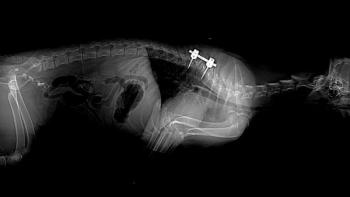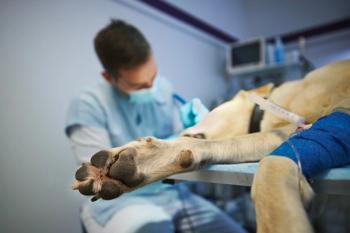
The flaccid dog (Proceedings)
The peripheral nervous system (PNS) consists of those structures (including cranial nerves and spinal nerves) containing motor, sensory and autonomic nerve fibers or axons that connect the central nervous system (CNS) with somatic and visceral end organs.
The peripheral nervous system (PNS) consists of those structures (including cranial nerves and spinal nerves) containing motor, sensory and autonomic nerve fibers or axons that connect the central nervous system (CNS) with somatic and visceral end organs. Lower motor neuron weakness refers to a lesion of the ventral spinal cord gray matter and its axon coursing to the muscle through the spinal nerve roots, peripheral nerve and across the neuromuscular junction.
A motor unit is composed of a neuron cell body, its axon, the neuromuscular junction, and associated muscle fibers. A group of myofibers innervated by one neuron is considered a motor unit. An abnormality in any portion of the motor unit can result in clinical signs of neuromuscular disease – lower motor neuron. The functional component of the motor unit involves the reflex arc. The arc consists of a sense organ, an afferent neuron (cell body in dorsal root ganglion), one synapse or more centrally, an efferent neuron, and an effector organ. An all-or-none action potential is generated in the afferent nerve and modulated centrally to be generated again as an all-or-none potential in the efferent nerve. The arrival of the action potential at the axon terminal triggers release of acetylcholine, producing an end-plate potential which if enough causes the postsynaptic membrane to depolarize.
Establishing an accurate diagnosis is based on following a logical sequence of diagnostic tests. History provides the signalment, presenting clinical signs, background, and time of onset and temporal progression of clinical signs. Specifically, disorders of the motor unit with acute onset include polyradiculoneuritis, tick paralysis, botulism and fulminant myasthenia gravis. Myopathic and neuromuscular junction (i.e., myasthenia gravis) diseases often are episodic in onset. The term fatigability describes when one or more muscles become weaker with repetitive but normal use and may imply neuromuscular junction disease. History is especially important for determining exposure to toxins. Often the diagnosis of an acute neuromuscular disease is determined by the history.
A physical examination is performed to localize the clinical signs and detect other systemic abnormalities. The neurologic examination will establish existence of peripheral nervous system disease and further assist with determining disease symmetry and distribution (focal, multifocal or diffuse). The neurologic examination should include sensory testing especially when determining the extent of traumatic neuropathy. Clinical signs of lower motor neuron weakness manifest as paresis, paralysis, hyporeflexia to areflexia and muscle atrophy that is severe and rapid-onset. Acute onset lower motor neuron diseases often have muscle flaccidity. Acute peripheral neuropathy of cranial nerves can occur with focal, multifocal or diffuse (polyneuropathy) disease. Mentation, gait, postural reactions and spinal reflexes are normal with focal neuropathy of a cranial nerve. Typically only one cranial nerve is affected. If there is disease of the brainstem, abnormalities involve mentation, postural reactions, gait and multiple cranial nerves. Neurologic deficits are more severe on the ipsilateral side. Myopathic and neuromuscular junction diseases also can mimic neuropathy of cranial nerves, i.e. myasthenia gravis will manifest clinical signs of megaesophagus (regurgitation). Proper neuroanatomic localization is crucial to the direction of the diagnostic approach.
A complete blood count, serum chemistry (including creatine kinase concentration and electrolytes) and a urinalysis serve to establish a baseline health profile and further identify other systemic abnormalities. Thoracic radiography may show evidence of concurrent megaesophagus and aspiration pneumonia which can be a sequela of peripheral neuropathy. Additionally, thoracic radiography and abdominal ultrasonography are used to screen for underlying metastatic disease and evidence of paraneoplastic neuropathy. CSF analysis will show abnormalities in cellularity and protein concentration with some peripheral neuropathies. Serology is useful to evaluate for infectious and immune mediated diseases. Endocrine function testing, especially thyroid hormone will further delineate underlying cause of the neuropathy.
Treatment protocols are guided by defining the underlying cause of the LMN signs.
Differential diagnosis of acute generalized lower motor neuron disorders
Polyradiculoneuritis (coonhound paralysis)
Frequently occurs in hunting dogs that have been exposed to raccoons. Raccoon saliva is believed to alter the peripheral nerve antigenicity, resulting in inflammation and l demyelination. Also is seen in dogs with no exposure to raccoons, suggesting that other factors (viruses, drugs, vaccines) can incite a similar immune reaction. Ventral roots and motor axons are preferentially involved. Analogous to a peripheral neuropathy of humans referred to as Guillain-Barre syndrome.
Clinical Signs – Typical ascending LMN paralysis, with paresis occurring 7 to 14 days after the raccoon bite and progressing to tetraplegia in 2-10 days. Diffuse spinal hyporeflexia and hypotonia. Neurogenic muscle atrophy is evident after 7-10 days. Generalized hyperesthesia may be seen. No sensory deficits. Cranial nerves usually are spared. The recurrent laryngeal nerve may be affected.
Diagnosis – Diagnosis is based on clinical signs and exclusion of other causes of tetraparesis. Characteristic EMG findings distinguish coonhound paralysis from other acute progressive LMN diseases. Denervation activity on EMG is seen after 5-7 days from onset of signs. Motor nerve conduction velocity is decreased indicating myelin involvement. Serology is used to rule out other infectious causes, i.e. protozoal.
Treatment – There is no definitive treatment. Supportive care is necessary to prevent decubitus ulcers and urine scald. Rarely, assisted ventilation may be indicated if respiratory compromise is severe. Physical therapy includes hydrotherapy, ROM exercises and sling support.
Prognosis – Prognosis is favorable if clinical signs are not severe and signs of recovery occur within several days. Relapse is not uncommon.
Tick paralysis
Neurotoxin secreted by tick species, Dermacentor andersoni, D. variabilis, Ixodes spp. Blocks the release of aceylcholine at the neuromuscular junction. The toxin may also alter ionic fluxes that mediate action potential production. Clinical signs are acute and develop 7 to 9 days after attachment of the tick.
Clinical signs – include rapid onset of paresis to tetraplegia. Spinal reflexes may be hypo- to areflexic. Cranial nerves usually are just minimally affected. Death can occur from respiratory failure if tick is not removed. Signs are more severe from the Ixodes tick in Australia.
Diagnosis – is based on clinical findings, identification of a tick and reversal of clinical signs after removal of the tick.
Treatment – Paresis is usually improved within 24 to 48 hours after bathing with insecticide and tick removal.
Prognosis – Prognosis is favorable in cases without respiratory signs.
Botulism
Clinical signs of botulism occur from ingestion of spoiled food or carrion contaminated with the exotoxin of Clostridium botulinum. Types C and D are most common carnivores. The toxin is internalized in the presynaptic terminal and blocks the presynaptic release of acetylcholine which subsequently blocks neurotransmission at both somatic and autonomic neuromuscular junctions.
Clinical signs – include progressive tetraparesis within 6 days of toxin ingestion. Often the pelvic limbs are affected first followed by thoracic limbs and cranial nerves. Spinal and cranial nerve reflexes are depressed to absent. Cranial nerve signs can be profound with laryngeal and pharyngeal weakness. Respiratory paralysis and autonomic dysfunction may occur in severe cases.
Diagnosis – based on clinical signs. The toxin may present in feces early in the disease course.
Treatment – usually consists of supportive care. Clinical signs will likely improve within 1 to 3 weeks. Antitoxin may be of benefit early in the disease but needs to be administered before the toxin binds to the presynaptic terminal. Antibiotic therapy is ineffective.
Prognosis – Generally favorable but guarded in animals with signs of respiratory distress and dysautonomia.
Myasthenia gravis
Acquired myasthenia gravis (MG) is an immune-mediated disorder in which autoantibodies against nicotinic acetylcholine (ACh) receptors of skeletal muscle result in impairment of neuromuscular transmission. This is manifested clinically as muscle weakness. Antibodies bind to the ACh receptor which is amplified by release of complement and a cell-mediated cytotoxic response at the endplates. The postsynaptic membrane is destroyed and neuromuscular transmission is disrupted. The decreased number of functional ACh receptors increases chance of failure of neuromuscular transmission. With repetitive firing of a motor nerve ending, stores of ACh are depleted; the few available ACh receptors are soon bound with ACh molecules and desensitized to further stimulation. This is the physiologic basis for fatigability which is a common clinical sign of patients with MG. It has been suggested that molecular mimicry of the ACh receptor by a short sequence of a bacterial or viral protein could initiate the immune response. The thymus is suspected to be the site of initiation of the autoimmune response to ACh receptors in MG.
Clinical Signs – Classic presentation of a dog with acquired MG is episodic, generalized muscle weakness that is worsened by exercise and improves with rest.
Diagnosis – Immunoprecipitation Radioimmunoassay is the gold standard test which uses radioactive iodinated a-bungarotoxin-labeled canine ACh receptors to quantitatively identify circulating antibodies directed against ACh receptors.
Edrophonium chloride (Tensilon) is an ultra-short-acting anticholinesterase agent. The drug provides more ACh molecules to interact with the available ACh receptors to improve muscle strength. A presumptive diagnosis of acquired MG may be made if a patient responds positively to IV injection of 0.1 to 0.2 mg/kg of edrophonium. A patient that demonstrates obvious improvement in muscle strength shortly after edrophonium is considered to have a positive response but the improvement only lasts for a few minutes. Administering edrophonium is not without risk. Overadministration of anticholinesterase agents is referred to as cholinergic crisis. Overstimulation of ACh receptors can produce depolarizing neuromuscular blockade and subsequent worsening of muscle weakness. Overstimulation of muscarinic ACh receptors can cause bronchoconstriction and bradycardia along with the SLUDD effect. The clinician should pretreat the patient with IM or SC atropine (0.02-0.04 mg/kg) and have the drug available for immediate IV administration to counteract undesirable muscarinic side effects. Since atropine is an antimuscarinic agent, the nicotinic receptors will still respond to the effects of edrophonium.
Therapeutic Options – In acquired MG, there are 3 major aspects of therapeutic intervention: anticholinesterase therapy, immunomodulatory therapy, and thymectomy. Approximately, 50% of cases may go into spontaneous remission given time. In veterinary medicine, anticholinesterase therapy is most widely accepted. Long-acting anticholinesterase drugs prolong the action of ACh at the neuromuscular junction by reversibly inhibiting acetylcholinesterase. This often provides improvement in muscle strength within the first few days of therapy. The agent most often used is pyridostigmine bromide (0.5 to 3.0 mg/kg every 8 to 12 h by mouth). To avoid overstimulation of ACh receptors, patients are started at the low end of the dose which is gradually increased as needed. Oral pyridostigmine is available in tablet and syrup form. In dogs with severe megaesophagus, intramuscular neostigmine bromide can be administered at 0.4 mg/kg. The dosages are titrated based on changes in muscle strength.
Excessive amounts of anticholinesterase drugs, results in the accumulation of ACh and cause fibrillation of muscle fibers. Paradoxical muscle weakness may occur as a result of this neuromuscular blockage of the motor endplate. Additionally, excessive stimulation of muscarinic receptors also will cause SLUDD (cholinergic crisis). This may be difficult to distinguish from worsening of the MG (myasthenic crisis) which also will reflect as profound muscle weakness. Edrophonium can be used to differentiate between these conditions. If the patient shows no relief or worsens with edrophonium, most likely excessive anticholinesterase is being used. The drug should be temporarily discontinued and dosage lowered.
It also is important to avoid drugs that may affect the neuromuscular junction. These agents may act presynaptic, synaptic, postsynaptic or in combination. These drugs include penicillamine, antimicrobial agents (aminoglycosides, ciprofloxacin, erythromycin, imipenem), pyrantel pamoate, β adrenergic antagonists, calcium channel blockers, antiarrhythmic drugs, neuromuscular blocking drugs, and others.
Newsletter
From exam room tips to practice management insights, get trusted veterinary news delivered straight to your inbox—subscribe to dvm360.






